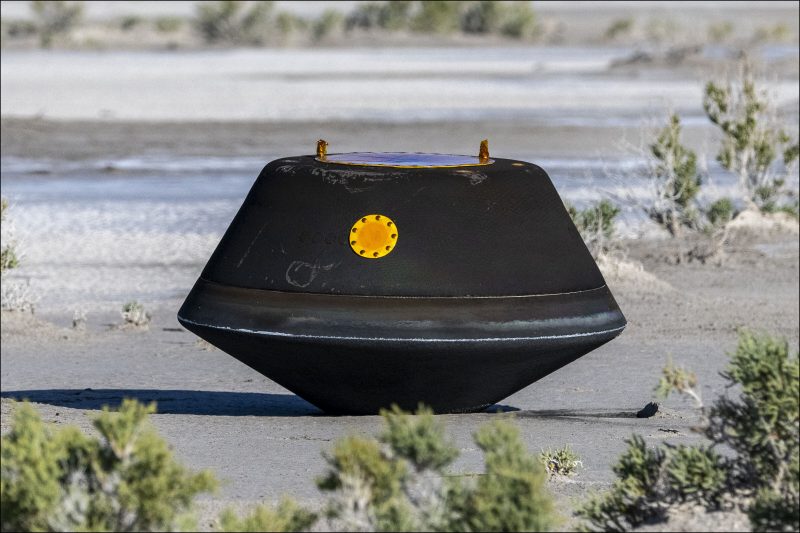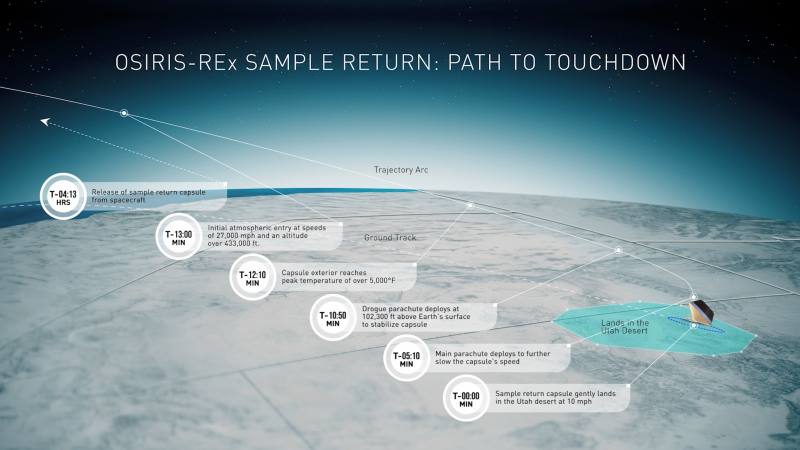
The OSIRIS-REx spacecraft dropped off an asteroid sample from Bennu on September 24, 2023. NASA aired live footage of the descent as it impacted with the Utah desert three minutes ahead of schedule. You can watch a replay of the coverage here. Teams on the ground quickly reached the landing site and determined that it was safe to transport the sample to a clean room in Utah. It will soon make a journey to Johnson Space Center in Houston, where a portion of it will be divided up and sent to scientists around the world for study. The spacecraft, now under the name OSIRIS-APEX, sped off toward its next mission: a rendezvous with asteroid Apophis.
Your package has been delivered.
The #OSIRISREx sample return capsule containing rock and dust collected in space from asteroid Bennu has arrived at temporary clean room in Utah. The 4.5-billion-year-old sample will soon head to @NASA_Johnson for curation and analysis. pic.twitter.com/Ke0PcDAKt0
— NASA (@NASA) September 24, 2023
After a journey of nearly 3.9 billion miles, the #OSIRISREx asteroid sample return capsule is back on Earth. Teams perform the initial safety assessment—the first persons to come into contact with this hardware since it was on the other side of the solar system. pic.twitter.com/KVDWiovago
— NASA (@NASA) September 24, 2023
TOUCHDOWN! The #OSIRISREx sample capsule landed at the Utah Test and Training Range at 10:52am ET (1452 UTC) after a 3.86-billion mile journey. This marks the US's first sample return mission of its kind and will open a time capsule to the beginnings of our solar system. pic.twitter.com/N8fun14Plt
— NASA (@NASA) September 24, 2023
Congratulations @NASA and the #OSIRISREx team on bringing a piece of space down to earth! What an amazing achievement! pic.twitter.com/ibd09fkIVc
— Chris “Hanks” Sembroski ?? (@ChrisSembroski) September 24, 2023
OSIRIS-REx’s journey to Bennu and back
OSIRIS-REx arrived at Bennu in 2018. In 2020, it touched down on the asteroid and scooped up material from the surface. Then, in 2021, the spacecraft left Bennu on its return mission to Earth.
When OSIRIS-REx dropped off the asteroid sample early Sunday morning, the capsule spiraled downward for hours before hitting Earth’s atmosphere. When it first hit the atmosphere, it was speeding at about 27,650 mph (44,500 kph). A heat shield protected the sample inside as the capsule temporarily became a superheated ball of fire.
Eventually, a series of parachutes deployed to slow the capsule further. By the time the capsule impacted the Utah desert, it slowed down to a speed of 11 mph (18 kph).

More about the asteroid sample from Bennu
NASA said the rocky asteroid sample from Bennu is an estimated 8.8 ounces, or 250 grams. It’s NASA’s first asteroid sample and the largest ever collected in space. Watch the video below for more.
Watch a video detailing OSIRIS-REx’s delivery of an asteroid sample to Earth. The sample from asteroid Bennu landed on Earth on September 24, 2023.
Continuing on to Apophis
After OSIRIS-REx fired its thrusters to keep it from colliding with Earth, it continued on its way, eventually headed for Apophis. Apophis is an asteroid famous for how close it will come to Earth. On Friday, April 13, 2029, the 1,100-foot (340-meter) space rock will come within 19,662 miles (31,643 km) of Earth’s surface. That’s closer than many Earth-orbiting satellites. As the asteroid encounters Earth’s gravitational field, one result could be asteroid-quakes on Apophis. This passage will also change the orbit of Apophis slightly. Some observers will even be able to see Apophis as it passes.
OSIRIS-APEX, now renamed for its new target of Apophis, will reach the asteroid in 2029. This extended mission will have OSIRIS-APEX orbiting and studying Apophis for a year and a half. The spacecraft will venture close enough to the asteroid to stir up loose material.

Bottom line: The spacecraft OSIRIS-REx dropped off an asteroid sample from Bennu on September 24, 2023, before continuing on a mission to Apophis as OSIRIS-APEX.
The post Asteroid sample returned safely to Earth first appeared on EarthSky.
from EarthSky https://ift.tt/coS3d1D

The OSIRIS-REx spacecraft dropped off an asteroid sample from Bennu on September 24, 2023. NASA aired live footage of the descent as it impacted with the Utah desert three minutes ahead of schedule. You can watch a replay of the coverage here. Teams on the ground quickly reached the landing site and determined that it was safe to transport the sample to a clean room in Utah. It will soon make a journey to Johnson Space Center in Houston, where a portion of it will be divided up and sent to scientists around the world for study. The spacecraft, now under the name OSIRIS-APEX, sped off toward its next mission: a rendezvous with asteroid Apophis.
Your package has been delivered.
The #OSIRISREx sample return capsule containing rock and dust collected in space from asteroid Bennu has arrived at temporary clean room in Utah. The 4.5-billion-year-old sample will soon head to @NASA_Johnson for curation and analysis. pic.twitter.com/Ke0PcDAKt0
— NASA (@NASA) September 24, 2023
After a journey of nearly 3.9 billion miles, the #OSIRISREx asteroid sample return capsule is back on Earth. Teams perform the initial safety assessment—the first persons to come into contact with this hardware since it was on the other side of the solar system. pic.twitter.com/KVDWiovago
— NASA (@NASA) September 24, 2023
TOUCHDOWN! The #OSIRISREx sample capsule landed at the Utah Test and Training Range at 10:52am ET (1452 UTC) after a 3.86-billion mile journey. This marks the US's first sample return mission of its kind and will open a time capsule to the beginnings of our solar system. pic.twitter.com/N8fun14Plt
— NASA (@NASA) September 24, 2023
Congratulations @NASA and the #OSIRISREx team on bringing a piece of space down to earth! What an amazing achievement! pic.twitter.com/ibd09fkIVc
— Chris “Hanks” Sembroski ?? (@ChrisSembroski) September 24, 2023
OSIRIS-REx’s journey to Bennu and back
OSIRIS-REx arrived at Bennu in 2018. In 2020, it touched down on the asteroid and scooped up material from the surface. Then, in 2021, the spacecraft left Bennu on its return mission to Earth.
When OSIRIS-REx dropped off the asteroid sample early Sunday morning, the capsule spiraled downward for hours before hitting Earth’s atmosphere. When it first hit the atmosphere, it was speeding at about 27,650 mph (44,500 kph). A heat shield protected the sample inside as the capsule temporarily became a superheated ball of fire.
Eventually, a series of parachutes deployed to slow the capsule further. By the time the capsule impacted the Utah desert, it slowed down to a speed of 11 mph (18 kph).

More about the asteroid sample from Bennu
NASA said the rocky asteroid sample from Bennu is an estimated 8.8 ounces, or 250 grams. It’s NASA’s first asteroid sample and the largest ever collected in space. Watch the video below for more.
Watch a video detailing OSIRIS-REx’s delivery of an asteroid sample to Earth. The sample from asteroid Bennu landed on Earth on September 24, 2023.
Continuing on to Apophis
After OSIRIS-REx fired its thrusters to keep it from colliding with Earth, it continued on its way, eventually headed for Apophis. Apophis is an asteroid famous for how close it will come to Earth. On Friday, April 13, 2029, the 1,100-foot (340-meter) space rock will come within 19,662 miles (31,643 km) of Earth’s surface. That’s closer than many Earth-orbiting satellites. As the asteroid encounters Earth’s gravitational field, one result could be asteroid-quakes on Apophis. This passage will also change the orbit of Apophis slightly. Some observers will even be able to see Apophis as it passes.
OSIRIS-APEX, now renamed for its new target of Apophis, will reach the asteroid in 2029. This extended mission will have OSIRIS-APEX orbiting and studying Apophis for a year and a half. The spacecraft will venture close enough to the asteroid to stir up loose material.

Bottom line: The spacecraft OSIRIS-REx dropped off an asteroid sample from Bennu on September 24, 2023, before continuing on a mission to Apophis as OSIRIS-APEX.
The post Asteroid sample returned safely to Earth first appeared on EarthSky.
from EarthSky https://ift.tt/coS3d1D

Aucun commentaire:
Enregistrer un commentaire